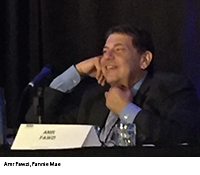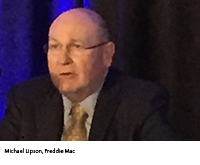
Record Volume, Increasing Servicing Complexity for Government-Sponsored Enterprises
PHOENIX–Fannie Mae and Freddie Mac financed record amounts of multifamily real estate last year and look to do even more, company executives said here at the MBA Commercial/Multifamily Servicing and Technology Conference.
The GSEs are also moving into new categories including green housing, which can create new challenges for servicers, said Freddie Mac Multifamily Senior Vice President of Asset Management and Operations Mike Lipson and Fannie Mae Director of Credit Risk Management Amr Fawzi.
Lipson noted Freddie Mac Multifamily funded $56.8 billion in new multifamily volume last year, providing financing for more than 4,600 multifamily properties. Fawzi said Fannie Mae’s Delegated Underwriting and Servicing program had $55.3 billion in new business volume last year, financing 724,000 multifamily units.
 “We are largely doing affordable housing,” Fawzi said. “We have basically moved off of Class A and roughly 87 percent of that total has been affordable to low- or moderate-income families earning 100 percent of area median income or below.”
“We are largely doing affordable housing,” Fawzi said. “We have basically moved off of Class A and roughly 87 percent of that total has been affordable to low- or moderate-income families earning 100 percent of area median income or below.”
Both the GSEs have dramatically increased their lending on environmentally efficient properties. “Freddie Mac elected to look at the requirement for sponsors to do a certain amount of work to their properties,” Lipson said, noting that sponsors get a discounted interest rate under the Freddie Mac Multifamily Green Advantage program. The program only applies to properties built before 2000 because more recent deliveries were built to be more resource-efficient, he said.
“We have set a minimum amount of work that they need to do to the product and there is a monitoring period afterward to make sure the cost savings are there,” Lipson said. “We’re now going to see the properties being made more energy efficient. We will monitor the first few deals, but we think it will be a successful program and will continue to grow it in 2017.”
Lipson said Freddie Mac exceeded $3 billion in green lending last year.
Fannie Mae delivered more than $3.5 billion in mortgage-backed securities backed by green mortgage loans in 2016, “with zero credit losses and zero delinquency,” Fawzi said. He noted that Fannie Mae offers three separate programs: Green Rewards for existing properties, Green Building Certification for new or existing properties awarded a green building certification and Green Preservation Plus for existing properties ready for energy- and water-saving improvements.
Fawzi said building owners must report the building’s Energy Star score using the EPA’s Portfolio Manager web site. “They must also report them to their servicers,” he said. “In addition, more and more municipalities are requiring Energy Star scores to be reported to them.”
 Lipson said the cash remittance side of the servicing business has changed little over the years. “What has changed is the information flow,” he said. “The demands from investors are increasing ten-fold. I think the demand for information is going to grow exponentially and we are going to have to keep up with it. Even though Fannie Mae was wrapping deals and we wrap ours, investors still want to know what is underneath that guarantee.”
Lipson said the cash remittance side of the servicing business has changed little over the years. “What has changed is the information flow,” he said. “The demands from investors are increasing ten-fold. I think the demand for information is going to grow exponentially and we are going to have to keep up with it. Even though Fannie Mae was wrapping deals and we wrap ours, investors still want to know what is underneath that guarantee.”
Multifamily servicers need to have a good conversation with originators to ensure everyone is working well together, Lipson said. “At this conference and other meetings we have with our servicers, we stress that they need to understand that specialization is coming through the expansion of new products,” Lipson said. “The servicing side has got to keep up.”
